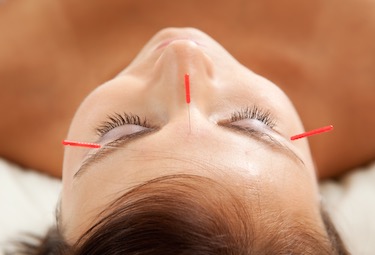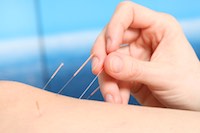Acupuncture enhances the therapeutic effects of paroxetine, a drug often given the trade name Paxil, Aropax or Seroxat. Patients receiving acupuncture plus paroxetine showed greater clinical improvements in obsessive-compulsive symptoms, depression and anxiety than patients receiving only paroxetine. Researchers discovered the synergistic effects of acupuncture combined with paroxetine plus another important advantage of adding acupuncture to paroxetine intake.  Acupuncture sped up the effective action of therapeutic benefits. The researchers note, “acupuncture/electroacupuncture has a rapid onset of therapeutic effect and produces a noticeable improvement in obsessive-compulsive, depressive and anxiety symptoms.”
Acupuncture sped up the effective action of therapeutic benefits. The researchers note, “acupuncture/electroacupuncture has a rapid onset of therapeutic effect and produces a noticeable improvement in obsessive-compulsive, depressive and anxiety symptoms.”
Acupuncture and electroacupuncture were found equally beneficial in overall therapeutic results. Scores in individual areas of improvement varied between acupuncture and electroacupuncture therapy when combined with paroxetine. Importantly, electroacupuncture showed significant improvements over manual acupuncture in reducing recurrent and multiple medical symptoms of no known organic cause. Electroacupuncture also demonstrated significant efficacy over manual acupuncture in reducing depression related hostility and phobic anxiety. Both manual acupuncture and electroacupuncture showed significant clinical benefits in reducing primary unipolar depression when combined with paroxetine with significant improvements over and above those of paroxetine only.
The researchers cite several important findings as the basis for the investigation. Roschke, et al. published in the Journal of Affective Disorders, “Acupuncture is more effective than oral antidepressants in improving depressive symptoms.” Yeung et al. document that acupuncture is effective for patients with “poor outcomes after antidepressant medications.” Zhang et al. confirm that acupuncture is both safe and effective for treating depression.
The study confirms three major findings. Acupuncture, electroacupuncture and paroxetine are effective in the treatment of primary unipolar depression. Acupuncture and electroacupuncture combined with paroxetine has a “rapid onset of therapeutic effect.” Additionally, acupuncture and electroacupuncture combined with paroxetine synergistically improves conditions of obsessive-compulsive behavior and anxiety in patients with depression. The results are better for patients combining acupuncture or electroacupuncture with paroxetine than those only taking paroxetine. The researchers also note that acupuncture and electroacupuncture combined with paroxetine “is a safe treatment for primary unipolar depression.”
The researchers used a standard set of acupuncture points with minor modifications for all patients in the study. This varies from customized clinical care wherein a licensed acupuncturist has more flexibility in the acupuncture point prescription based on differential diagnostics. Although the approach of using one set of acupuncture points for all patients is common in many research models, it is considered a variation from the norm according to Traditional Chinese Medicine (TCM) principles wherein each patient receives a custom acupuncture point prescription based on an exact presentation of conditions.
The research team cited several studies finding the governing, pericardium, spleen, liver and stomach meridians effective for the treatment of depression. These findings combined with a presentation of Chinese medicine principles for the treatment of depression were given as the reasoning for the acupuncture point choices. The primary acupuncture points used in the study were Baihui (DU20), Yintang (EX-HN3), Fengfu (DU16), Fengchi (GB20), Dazhui (DU14), Neiguan (PC6) and Sanyinjiao (SP6). Minor customizations based on some indications were added. Zusanli (ST36) was added for cases involving poor appetite or fatigue. Shenmen (HT7) was added for patients with sleep disturbances. Shuaigu (GB8) was added for patients with headaches. Zhigou (TB6) was added for patients with constipation.
Wang, et al. confirm that acupuncture combined with SSRIs (serotonin reuptake inhibitors) is more effective than using SSRI medications alone. The additional research also confirms that acupuncture potentially reduces the “delay before the onset of the therapeutic action of SSRIs.” Wang, et al. note, “Acupuncture combined with SSRIs shows a statistically significant benefit over a 6-week period compared with SSRI administration only.” The research team notes that acupuncture is safe and produces no adverse effects. Wang, et al. add that acupuncture may allow for “the reduction of the dose of antidepressants and their associated adverse clinical outcome.”
The researchers note, “We showed that acupuncture combined with SSRIs produces statistically significantly larger reductions of HDRS (Hamilton Depression Rating Scale) values than SSRIs alone. This additional benefit was evident from the first week and continued throughout 6 weeks of treatment.” The investigators note that these findings are consistent with another body of research including a 6 week controlled, randomized trial of acupuncture combined with paroxetine.
Psychiatrists prescribed SSRIs to each patient in this randomized, controlled study. The acupuncture group received SSRIs plus acupuncture therapy. The control group received SSRIs only. A differential diagnosis was made for each patient by a China Association of Acupuncture and Moxibustion certified acupuncturist with a minimum of 15 years of clinical experience. The standard of care was protocolized to a given set of primary and secondary acupuncture point prescriptions. Between 6 and 10 needles were applied to each patient at each office visit. The acupuncture needles were 0.25 × 40 mm and the depth of insertion was 10 – 30 mm. Needles were stimulated until deqi arrived. The dao qi acupuncture technique was applied to the primary acupuncture points. Dao qi is lifting, thrusting and rotating the acupuncture needle with gentle and smooth stimulation.

GV14 and GV4 were needled in the seated position with a 5 minute retention time prior to removal of the needles. Next, patients were in the supine position for additional acupuncture care for 30 minutes. Treatment was applied once per day in the morning at a rate of 5 days per week for a total of 6 weeks.
The primary acupuncture points were GV24 (Shenting), GV20 (Baihui), GV14 (Dazhui) and GV4 (Mingmen). Secondary points were:
- LR3 (Taichong), SP9 (Yinlingquan) for liver depression & spleen deficiency
- LR3, LR14 (Qimen) for liver qi stagnation
- HT7 (Shenmen), ST36 (Zusanli) for heart and spleen deficiency
- KI3 (Taixi), LR3 for liver and kidney yin deficiency
- CV4, CV6 for spleen and kidney yang deficiency
- HT7 and Anmian for insomnia and forgetfulness
- PC6 (Neiguan) for palpitations and chest tightness
- ST25 (Tianshu), ST37 (Shangjuxu) for constipation
Mental illness is a serious individual and societal issue. Working towards more effective treatment protocols and greater access to care will help in the treatment of depression. Given the increasing body of evidence that acupuncture enhances the clinical benefits of paroxetine, an integrative medicine approach seems more rational than a medication only approach. Let’s look forward to acupuncture treatments becoming recommended and available to patients needing care in the treatment of depression.
References:
Chen, Junqi, Weirong Lin, Shengxu Wang, Chongqi Wang, Ganlong Li, Shanshan Qu, Yong Huang, Zhangjin Zhang, and Wei Xiao. "Acupuncture/electroacupuncture enhances anti-depressant effect of Seroxat: the Symptom Checklist-90 scores." Neural Regeneration Research 9, no. 2 (2014): 213.
Wang, Tianjun, Lingling Wang, Wenjian Tao, and Li Chen. "Acupuncture combined with an antidepressant for patients with depression in hospital: a pragmatic randomised controlled trial." Acupuncture in Medicine (2014): acupmed-2013.
Qu SS, Huang Y, Zhang ZJ, et al. A 6-week randomized controlled trial with 4-week follow-up of acupuncture combined with paroxetine in patients with major depressive disorder. J Psychiat Res 2013;47:726–32.


